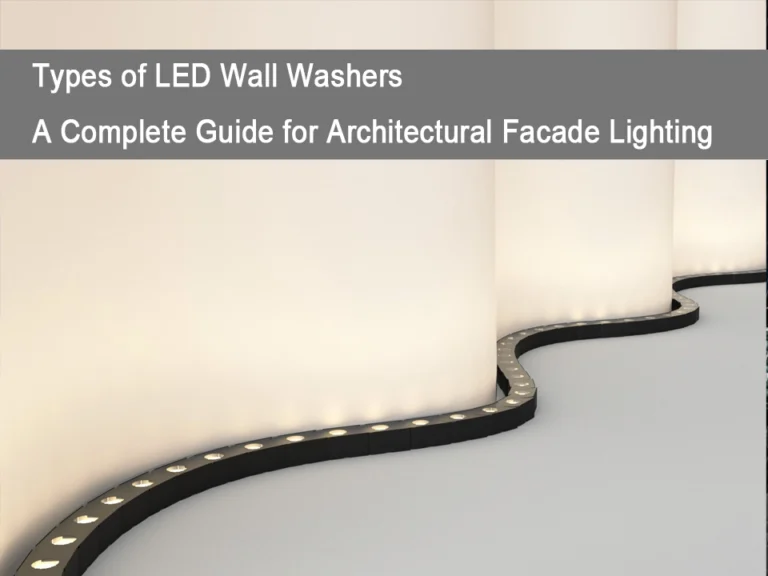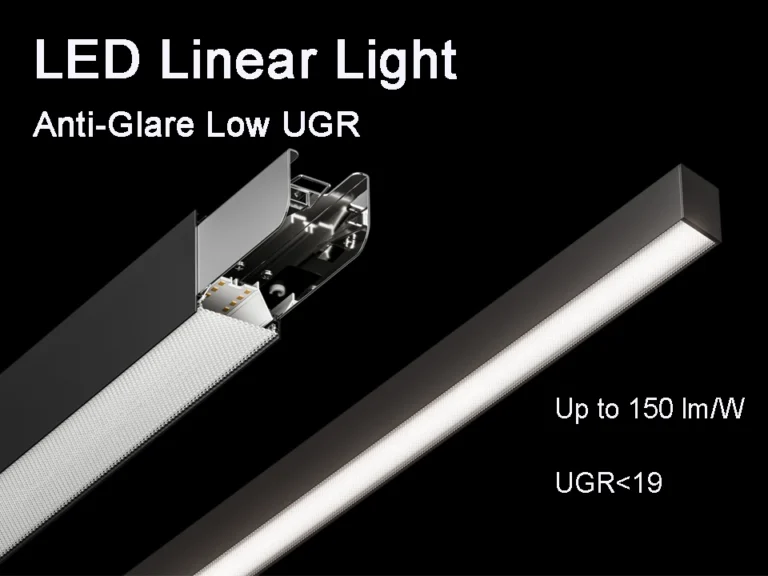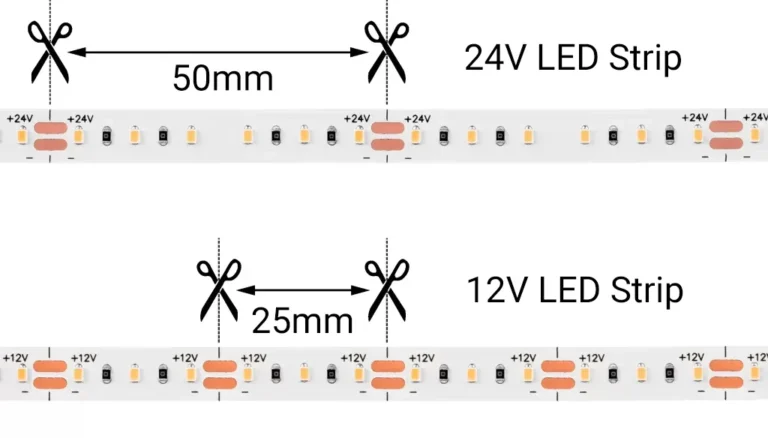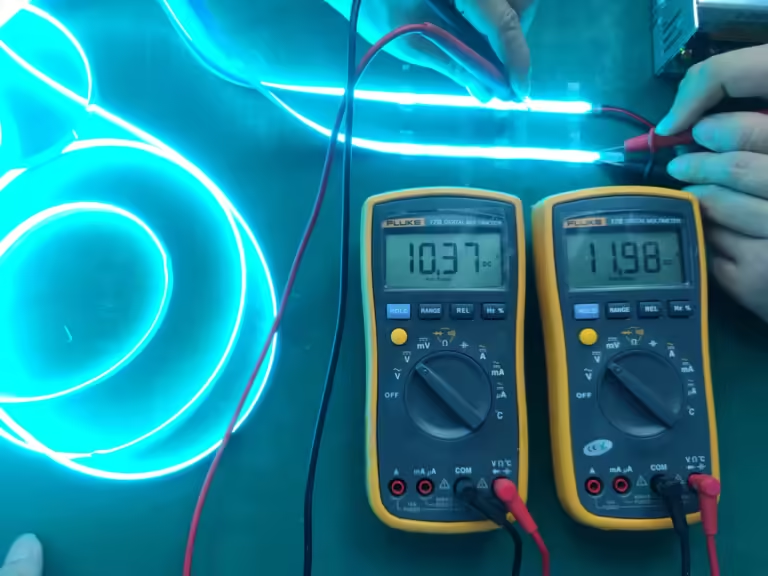在实际照明项目、模型室施工或现场安装中,由于电源配置不一致,12V LED 灯条连接到 24V 电源的情况并不少见。 虽然这看起来像是一个简单的“电压不匹配”,但它可能会导致严重的问题,例如烧坏的 LED、过热和吸烟、产品故障,甚至项目延迟。
对于 LED 灯带集成商、建筑照明承包商和批发购买者来说,在不更换整个系统的情况下找到技术替代解决方案变得至关重要。
本文将系统地分析:
- 电压失配的工作原理和风险
- 24V 系统中 12V LED 灯条的应用限制
- 可行的降压和隔离解决方案
- 如何根据项目场景选择安全电源设计
如果您正在寻求稳定且具有成本效益的解决方案,本文还将提供推荐的LED条带产品和技术支持建议。
为什么 12V LED 灯条不能直接与 24V 电源一起使用?
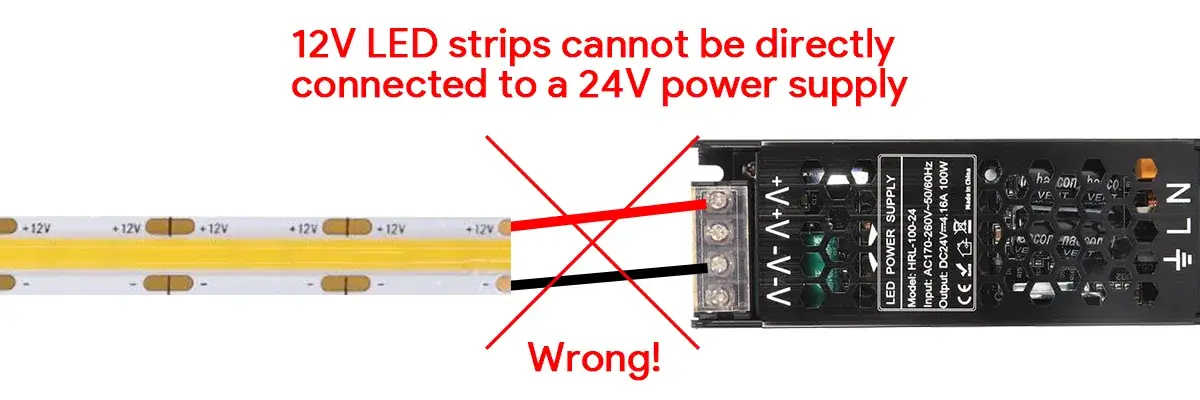
在LED照明项目中,12V和24V是最常见的两种低压标准。 虽 12V 和 24V LED 灯条 外观相似,其内部电路设计、电阻分布和承载电流能力完全不同。 将 12V 带连接到 24V 电源会直接导致电压过载,导致以下严重后果:
过电压的后果
12V 条在 12V 电压下工作,当连接到 24V 直流电源时,它的额定电压会超过其极限。 常见问题包括:
- LED芯片的瞬间烧毁:LED芯片设计为在12V电流下运行。 连接到24V时,电流会加倍,导致严重的过热,可能导致LED芯片烧坏或变色。
- 电阻过热损坏:串联连接的LED灯条中的限流电阻严重过热,可能导致电阻器失效、PCB变形,甚至是烟雾或火灾的风险。
- 整个灯带呈现不可用:一旦电路损坏,维修成本超过了更换整个灯带的成本,尤其是在安装场景中,这尤其具有挑战性。
LED烧坏背后原理分析
LED 是从根本上说是电流驱动的设备,电压的变化会导致电流迅速上升。 通常,12V 灯带由一系列串联并并联的三个 LED 组成,并带有限流电阻器以保持恒定的亮度。 连接到 24V 时,不受控制的电流会导致以下现象:
- 串联LED 失去电流共享保护:如果一颗LED烧坏,整个组停止工作,影响整个灯带。
- 电阻过热,导致电路板表面碳化。
- 正极端子过压击穿会导致电路短路。
现场使用风险明显高于实验室环境
在实验室环境中,即使短时间连接到 24 V 并没有立即烧毁灯带,在以下工程场景中的风险也会显着增加:
- 批量并行安装:增加的功率负载,一旦一个部分失败,它可以很容易地触发倦怠的连锁反应。
- 户外或封闭 铝通道 环境:散热不良,导致热失控。
- 灯条的隐藏安装: 烧毁被发现较晚,导致维护成本高。
电压不匹配不是“小问题”,而是严重影响灯条寿命、安全和项目交付时间线的严重危险。 对于任何优先可靠性的商业照明项目,防止 12V 灯条连接到 24V 电源是最基本的电气设计标准之一。
我可以在 24v 电源上安全运行 12v LED 灯带灯吗?
从技术上讲,是的,您可以——但前提是您将它们串联正确连接。
虽然我们强烈建议使用为正确电压指定的产品和配件,但我们将向您展示如何将 12V LED 灯带连接到 24V电源 不损坏LED灯条!
免责声明:不正确或意外的连接导致过电压可能导致 LED 永久性损坏。 此处提供的信息仅用于教育目的。 Signliteled 对任何损坏不承担任何责任。
出于安全考虑,我们建议使用同一 12V LED 灯条的两个短部分进行测试,以确保在连接较长的部分之前正确设置所有内容。
正确的接线方式:串联连接
理论上,将两个相同的 12V LED 灯条串联连接会产生 24V 的总电压,使其与 24V 系统兼容。 通过以这种方式连接LED灯条,24V电源在两个LED灯条段之间有效地“分裂”,每个段接收12V,由于两个LED灯条串联,因此每个LED灯条消耗相同的电流。 具体连接方式请参考下图。

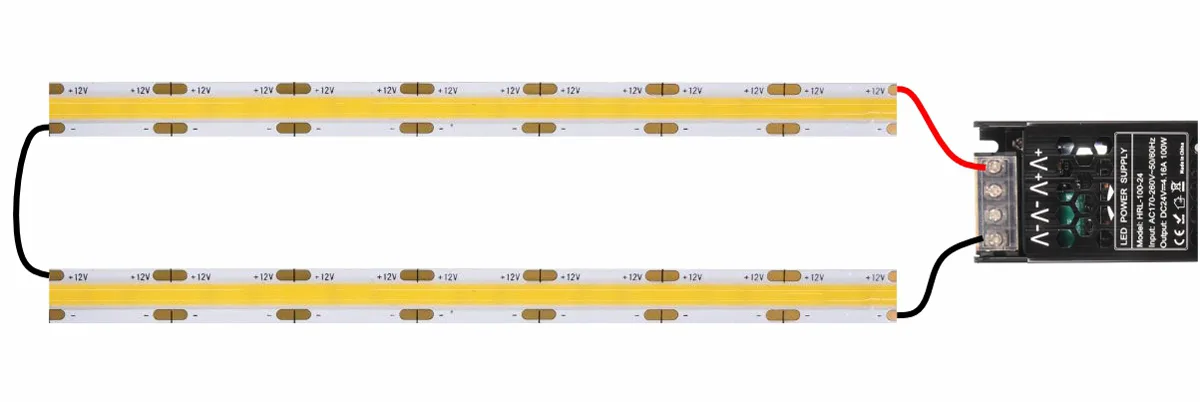
警告:串联连接的两个 LED 灯条必须完全相同!
为什么这这么重要?
假设两个不同长度的 12V LED 灯条串联连接。 在12V电压下,它们分别消耗0.5A和1.0A的电流。 由于它们是串联连接的,因此它们将被迫共享相同的正向电流值。 假设当前值正好是 0.75A(中点)。
对于较长的LED灯带,要匹配较低的电流0.75A(而不是额定1.0A),电压可能需要降至11V甚至10V。但是,正如名称所表明的那样,24V恒定电压输入保持恒定在24V。因此,较短的LED灯带现在被迫“弥补”剩余的13V或14V电压。 这将导致较短的 LED 灯带出现过流情况并可能损坏 LED。
只有在串联配置中,12V LED 灯条才能在 24V 电源上运行。 虽然这项技术是智能的、可扩展的,并且对教学和安装非常有用,但它可能会对实际工程项目安装造成重大风险:
- 必须使用相同的条带长度和类型。
- 可能发生不均匀的电压分布。
- 一个条带的故障可能会影响另一条带。
电阻的任何变化、不一致的焊接或条带的老化不均可能导致电压分布不均匀,从而增加了损坏的风险。 因此,我们建议仅在紧急情况下使用此方法!
有关如何将 LED 灯带连接到电源的更多信息,请阅读博客文章 将 LED 灯条连接到电源的终极指南 和 将 LED 灯条连接到电源的方法.
更好的技术解决方案:如何在24V系统中使用12V LED灯
在一些项目站点,已经统一部署了 24V 电源系统。 但是,由于库存问题、外包或后期要求的变化,可能需要暂时使用 12V LED 灯带灯。 如果LED灯本身无法更换,是否有办法将它们安全地连接到24V电源系统? 答案是肯定的,但必须使用专业的降压方法来确保系统稳定性和安全运行。
解决方案 1:使用 DC-DC 降压转换器
这是最常见和最安全的方法。 通过在电源输出和LED灯条之间插入DC-DC降压转换器,24V电压可靠地转换为12V输出,确保LED灯条正常运行。
优势
- 精确输出12V,与所有12V LED灯条型号兼容;
- 可并联多个模块,为分段式电源提供便利,便于布线;
- 提供过压保护和过载保护的工业级模块,以增强系统稳定性。
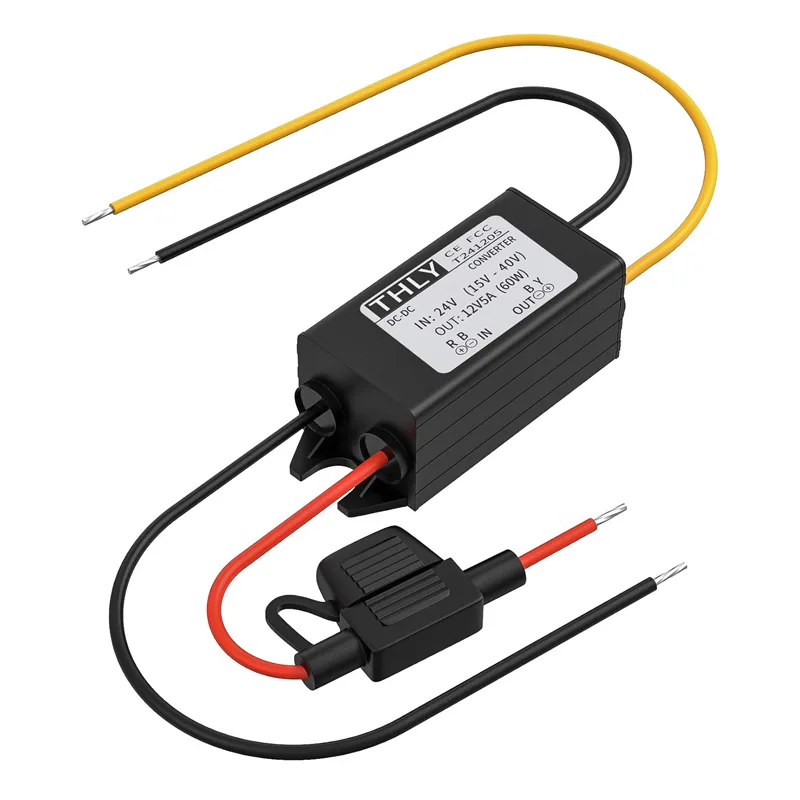
DC24V-12V降压转换器
输出电压DC12V
最大电流:5A 60W
效率:96%
防水:防水等级:IP67
产品尺寸:L114 x W79 x H20 mm
净重:264g
应用场景:
- 购物中心展示柜和窗户照明;
- 可调节的展览和展示灯光;
- 带分段控制的室内照明系统。
推荐的注意事项:
- 模块电源必须满足灯条的总功耗;建议保留20%-30% 的余量。
- 首选具有短路保护和稳压功能的产品;
- 安装时要注意散热和防水(如用于户外项目)。
解决方案 2:双电源系统配置(隔离电源)
在中大型项目中,还可以采用双电源系统,其中24V主电源驱动24V设备,并在电源12V灯条中增加12V电源。
优势
- 独立控制每个系统,便于维护;
- 更适合对电源干扰敏感的高端项目;
- 可与DMX、DALI等智能控制系统结合部署。
适用场景:
- 酒店、商业综合体、博物馆等多系统照明项目;
- 在项目实施期间添加 12V 模块时更容易集成。
注:
- 两个电源组不能共享一个共同点,必须完全隔离;
- 需要清晰的电路标签,以防止在实施过程中接线错误;
- 控制系统必须根据电压段进行分组。
解决方案 3:集中式电源 + 模块化输出设计(适用于集成系统)
对于分布式照明控制系统(如大型智能照明平台),可使用集中式电源柜统一输入24V电源,然后通过模块化输出板将其转换为12V信号。
优势
- 集中管理和模块化安装;
- 适用于工业照明和智能建筑控制系统;
- 降低维护成本,便于故障诊断。
缺点
- 更高的初始部署成本;
- 建筑布线的一定要求。
不推荐的解决方案:串联灯条、电阻器电压降低等。
虽然从电路理论的角度来看,通过增加串联电阻或多串联连接可以实现电压降低,我们在上一章中也详细介绍了该解决方案的连接和原理,这些方法在实际照明项目中会带来很高的故障率和安全隐患:
- 串联LED灯带受元件均匀性的显着影响;
- 电阻器电压降低方法效率低,产生过热;
- 该解决方案缺乏保护机制,电压波动很容易损坏设备。
因此,对于专业项目,选择具有稳定输出和保护功能的标准化降压模块或分组电源系统至关重要。
虽然确实存在 12V 灯条与 24V 系统不兼容的解决方案,但它们需要适当的规划和标准化选择。 根据项目规模、安装环境、控制系统的不同,选择适当的降压方式既可以降低装修成本,又能保证系统长期稳定运行。
替代建议:选择兼容电压的 LED 灯带产品
虽然降压解决方案可以使 12V LED 灯条与 24V 系统兼容,但从项目安全性、稳定性和维护成本的角度来看,我们建议选择 LED灯带产品 与项目一开始就为系统提供兼容电压。 该策略可以有效降低工程故障率,提高整体系统效率,延长使用寿命。
因此,您需要根据您的项目选择正确的解决方案。 在决定是否在 24V 系统中使用 12V LED 灯条时,请问自己:
- 这是临时设置还是永久设置?
- 我可以使用降压转换器或附加电源吗?
- 我可以安全地串联连接吗?
- 从长远来看,升级到 24V 电源板会更高效吗?
最实用的解决方案是升级到24V LED灯条。 如果您的系统已经标准化了 24 V 的电压,升级可以简化安装和电源管理。 为什么24V优先于12V? 与12V系统相比,24V LED灯条在中长距离安装中具有显着优势:
- 更低的电压损耗:在相同的电流条件下,24V系统的线路损耗是12V系统的一半,更适合长距离布线;
- 每单位电流更低,使系统更安全:降低电缆过热和短路的风险;
- 可以制作成更长的单段:避免过多的拼接点,提高光效的一致性;
- 与 DALI 和 DMX 等智能照明系统更好地兼容:更容易实现集中电源和数字调光。
因此,如果您的项目已经是 24V 电源系统,那么选择 24V 灯条是最可靠的选择。
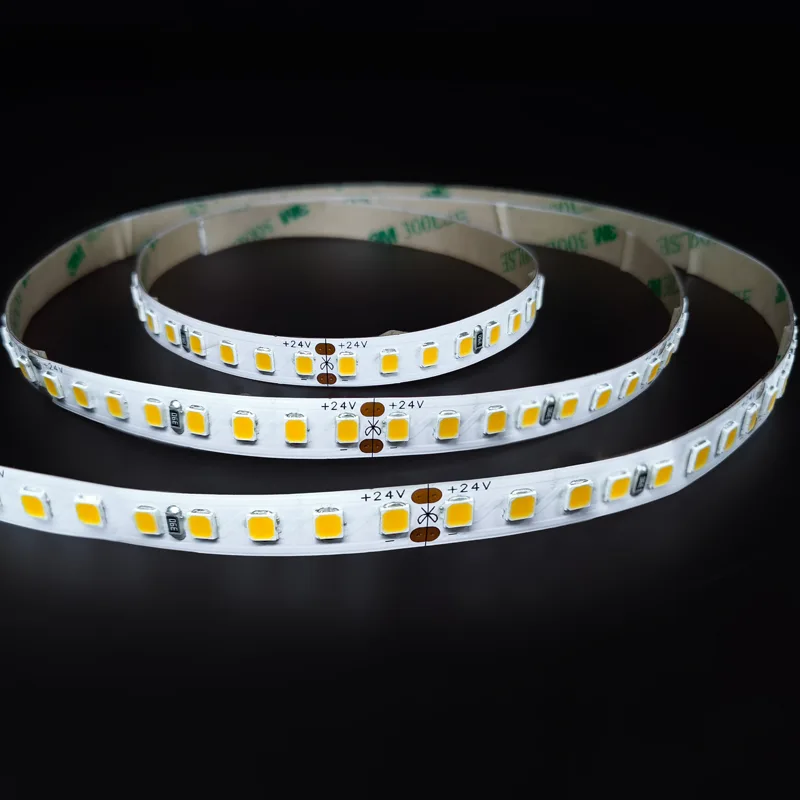
高效 DC24V LED 灯带灯
型号 FQX10T128C
电压 DC24V
动力 12 瓦/米
效率: 190-200lm/W
Ra: >80
CCT: 3000K – 6500K
LED 类型: SMD2835
LED 数量 128LEDs/m
PCB宽度: 10 毫米
切割单位: 62.5 毫米/8 个 LED
IP 等级: IP20/IP54/IP65/IP67/IP68
保修单: 5 年
选择建议:为您的项目选择合适的电压 LED 灯带
| 项目类型 | 推荐电压 | 论证 |
| 商业空间天花板灯槽 | 24V | 安装距离长,集中电源,线路损耗最小 |
| 展示柜或窗户照明 | 12V/24V | 取决于灯条的长度和电源位置 |
| 智能建筑调光系统 | 24V | 与 DALI 和 DMX 控制器更兼容 |
| 定制家具照明 | 12V | 分布式电源、不同长度的灯条和柔性布线 |
| 室外防水灯带系统 | 24V | 更稳定的大功率驱动器和更强的电压电阻 |
选择正确的电压是决定项目成功的第一步。 与其在施工后期进行修正,不如在初始选择阶段彻底考虑系统兼容性、电路设计和产品性能,以确保一次性安装和长期稳定性。 在实际项目实施中,我们建议与有工程经验的供应商合作,根据电压、电流要求、控制方法和安装环境定制系统。
如果您仍有关于选择 24V 或 12V LED 灯条的问题,SignLiteLED 可提供以下支持:
- 工程电源和LED灯带系统匹配设计;
- DC-DC 降压模块和集中式电源解决方案;
- 批量供应和OEM定制服务,适合各种商业项目。
请 联系我们 用于项目评估和专业建议。
摘要:如何降低与不匹配的12V/24V系统相关的风险
在商业照明和工程项目中,LED灯带照明系统的稳定运行不仅取决于产品本身的质量,还取决于电源系统的合理性和符合安装标准。 本文通过多种解决方案和技术分析确定了将 12V LED 灯条直接连接到 24V 电源的高风险实践,它很容易导致条带损坏和项目返工。
如果由于项目要求或库存限制,在24V系统中使用12V条是必要的,应选择专业的降压模块或隔离式电源系统作为过渡措施,以确保设备的安全和使用寿命。
从长远来看,从项目一开始就选择与电源系统电压相匹配的 LED 条产品是降低工程复杂性并最大限度地减少安装后维护的最佳策略。
LED灯带灯电气标准推荐清单
| 项目阶段 | 推荐 |
| 原理图设计阶段 | 指定系统电源电压(12V 或 24V),以避免混用多个电压 |
| 光带产品选择 | 优先选择与系统兼容的电压版本,例如 24V 系统的 24V 照明灯条 |
| 现场布线安装 | 严格禁止将 12V 照明灯条直接连接到 24V 电源;必须使用 DC-DC 降压模块或隔离电源 |
| 电源设备采购 | 选择具有短路、过压和过热保护功能的电源和降压模块 |
| 灯带安装测试 | 安装每个部分之前进行分段照明测试,以防止在全电路通电后出现故障 |
| 项目交付和验收 | 验证电源和灯带模型是否匹配,并记录电源图和灯带布线计划 |
如果您的项目需要跨电压兼容性解决方案、集中电源设计或定制模块,请联系 SignliteLED 团队。 我们提供全面的 LED灯条照明 系统设计支持,帮助您的项目实现高效交付和稳定运行。
常见问题
我们不建议这样做。 即使短期内不烧坏,也会大大缩短灯带的使用寿命,可能会造成安全隐患。 一些光珠在高温下可能会出现轻微的变色或亮度下降,并且风险难以控制。
不建议这样做。 虽然理论上可以共享电压,但不一致的阻抗和电阻很容易导致一个部分首先烧毁,而另一部分不受保护并触发连锁反应。
1。 确保输出功率满足LED灯条的总功耗并允许留有余量。
2 。 模块应具有短路、过压和过热保护功能。
3。 在室外或高温环境中,加强散热或防水措施。
可使用双电源系统或集中式电源+模块化输出配置。 关键是确保不同电压系统之间的物理隔离,线路清晰,独立控制,图纸上的清晰标签。
检查灯带标签、电源接口标签或使用万用表测量工作电压。 建议在施工前管理光带电压批次,以避免因混合不同电压而造成误连接。
